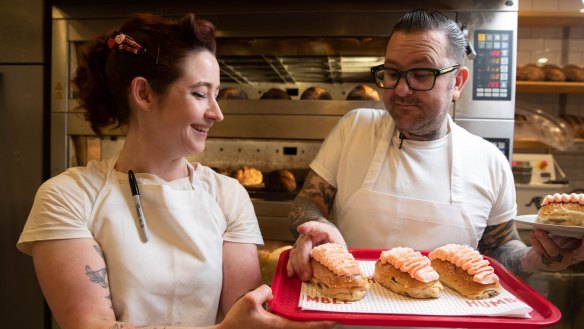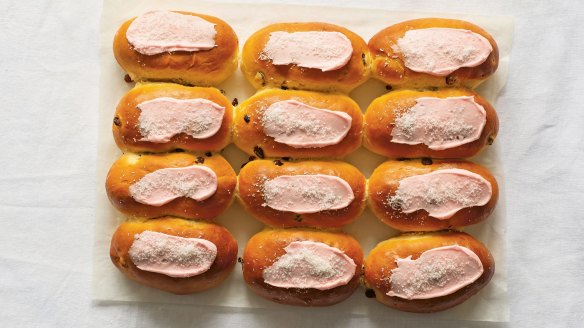Tickled pink: the finger bun is back, and it’s no longer just a tuckshop treat

The nostalgia attached to our favourite home-grown pastries continues, this time in a shade of Millennial pink. The modest finger bun – a staple of brown paper bags – is back in vogue, decorated with decadence from Surry Hills to London.
The yeast-risen treats are popping up in cabinets at Surry Hills' Humble Bakery, who decorate theirs with a ribbon of pastel pink cream-cheese icing, and Woolloomooloo's Flour and Stone (with a cardamom and coffee cream, topped with almonds – recently replaced with a seasonal Easter bun).
Brisbane's Florence Cafe decorates the treats with lemon custard and figs and they're even as popular in the UK. At Spring restaurant in London, Sydney-born chef Skye Gyngell and her team are producing finger buns lacquered in thick Millennial pink frosting, so decadently drippy it looks like a cartoon.

"When we first sat down and were trying to decide what we were going to bake, the finger bun came up," says Humble Bakery co-owner Ben Milgate. "Kind of the classic at the canteen or Bakers Delight when you're a kid; we definitely wanted to recreate that ... but a little different." The Humble bun features dried cranberries, golden raisins and currants – and a slab of butter.
But what we know as a finger bun today is a relatively new concept, says culinary historian Jacqui Newling. Traditionally, "bun" was a term used to describe circular breads, baked either individually or in a pan, with dried fruit to sweeten (in the absence of affordable or plentiful sugar) and typically a light sugar glaze. The long, tubular, icing-slathered number is probably a derivative of this yeasted fruit bun, says the author of Eat Your History and curator at Sydney Living Museum. Its return to prominence is less easy to track.
"I think all these things have taken on a nostalgia value. There's so much more sort of global influence in our cake selection – we've got friands, cannolis and muffins ... the bun has become quite humble in a way," says Newling.

While there are references to "lady finger bun trays" in advertisements from the 1930s, mentions in The Australian Women's Weekly suggest the finger bun as we know it today came into its own in the 1970s – as did enjoying them iced, as opposed to glazed, with that quintessential pink stripe.
"The idea of the pink stripe down the middle was certainly a thing in the 1970s," says Newling. "[Finger buns] really seemed to come into their own in Australia in the 1970s. I think a lot of it comes from retailers, bakeries and things, [and] having a shop window [where] you want things to look cheerful and colourful. When you're really using the same kind of basic dough, it's the shape and what you add to it that distinguishes it from other things."
Cookbook author and chef Ross Dobson is adamant that a finger bun without the stripe isn't really a finger bun at all.
"Must have dried fruit. Butter optional. Must have pink icing. Coconut optional," he says. He scratches the resurgence of the finger bun down to a parallel resurgence of home baking, and tuning it to childhood favourites in the process.
"I think over the past 12 months there's been a real resurgence in nostalgic baking ... people were definitely turning to old school nostalgia to make them feel safe ... And maybe there's that crossover with this resurgence now," says the author, whose new book, Australia: The Cookbook, features a recipe for the very pink, fruity version.
"And I think the finger bun is now far enough removed from some people's minds to be cool again. I would say there's a resurgence in interest because people have gone, 'oh wow, this is actually really good'."
Finger buns have been on the Bakers Delight menu since the chain started in 1981. Their finger buns are decorated with white icing topped with 100s and 1000s or choc chips, Boston icing and coconut or cinnamon sugar, chocolate icing with chocolate chips, and the classic pink icing.
"You just can't keep a great treat down," says Lesley Gillespie, co-founder of Bakers Delight.
Passing down humble Australian recipes is essential, says Nelleke Gorton, the president and cookery officer at the Country Women's Association Bega branch. But it's especially important that they're fun to make.
"I totally believe in fun. If it's not fun, it's not worthy. It's gotta be fun to make and bake," she says.
Milgate says – hype aside – that's really what it's all about.
"It's still just a finger bun. It's white bread with fruit and frosting. Bloody delicious, but yeah, it's not a new thing. It's just a classic done well, with good ingredients. It's not earth-shattering but it's delicious and it takes people back to growing up."